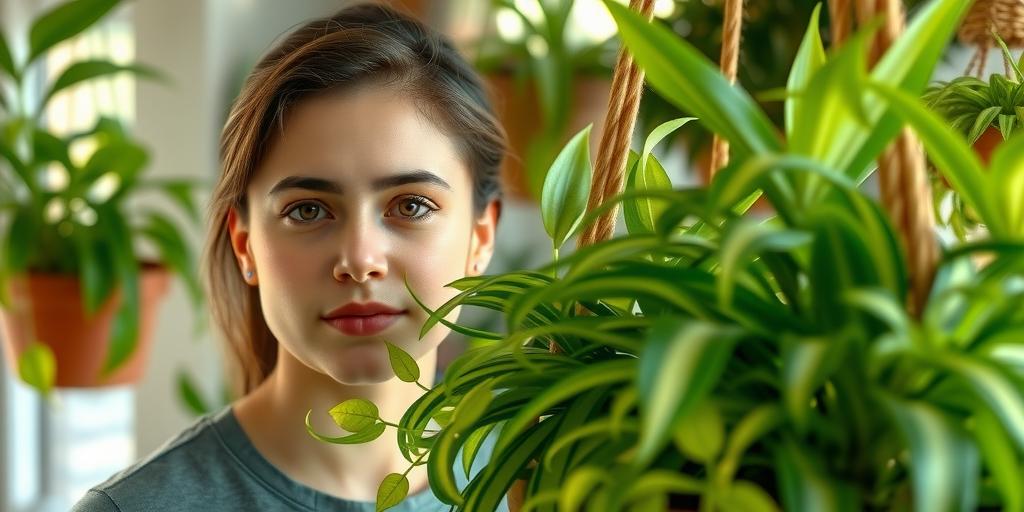
The Ultimate Guide to the Best Hanging Plants for Humid Low Light Environments
Discover the best hanging plants that thrive in humid, low light environments! Our guide covers top plant picks, care tips, and styling ideas to transform your space into a lush, green oasis.
Introduction
Does your home have a dim, humid corner that feels impossible to decorate? You’re not alone! Many plant lovers struggle to find greenery that can survive away from bright, sunny windows. But what if I told you that some of the most beautiful and resilient plants actually prefer these exact conditions? In fact, many tropical understory plants are naturally adapted to low light and high humidity, making them perfect candidates for that challenging spot in your bathroom or north-facing room. Get ready to turn that forgotten space into a thriving indoor jungle! This guide will walk you through the very best hanging plants that not only survive but truly flourish in humid, low light environments.
Why Choose Hanging Plants for Humid, Low-Light Spaces?
When you’re working with limited floor space or awkward corners, hanging plants are a game-changer. They allow you to utilize vertical space, drawing the eye upward and adding depth to a room. Hanging planters can turn an empty corner or a bare wall into a lush, green focal point. Plus, they keep your plants out of reach from curious pets or small children—an added bonus for many plant parents!
Humidity often gets a bad rap, but for many plants, it’s a secret superpower. In humid environments, plants lose less water through their leaves, meaning they require less frequent watering. This is especially helpful if you’re the type who occasionally forgets to water your green friends. Many popular houseplants originate from tropical rainforests, where humidity is high and light filters through dense canopies. By placing them in a humid spot, you’re essentially recreating their natural habitat.
Low-light tolerant plants are often slower growers, which translates to less maintenance. You won’t need to repot them as often, and they’re generally more forgiving if you miss a watering or two. These plants have adapted to thrive with minimal light, making them perfect for spaces like bathrooms, hallways, or north-facing rooms that don’t get much sun.
Beyond their practical benefits, hanging plants in humid, low-light areas can significantly improve your indoor air quality. Many of these plants are known for their air-purifying qualities, filtering out common toxins and releasing oxygen. They also bring a calming, natural element to spaces that might otherwise feel sterile or overlooked.
Top 10 Best Hanging Plants for Humid Low Light Conditions
Heartleaf Philodendron
If you’re new to plant parenting, the Heartleaf Philodendron is your best friend. This plant is incredibly forgiving and thrives in low light and high humidity. Its heart-shaped leaves trail beautifully from hanging baskets, and it grows quickly even when neglected. It’s the perfect plant to build your confidence.
Pothos (Devil’s Ivy)
Pothos is another beginner-friendly option that adapts to almost any condition. Its vines can grow impressively long, and it comes in several eye-catching varieties like Golden Pothos (with yellow variegation) and Marble Queen (with white and green marbling). It tolerates low light well and enjoys the extra moisture in humid spaces.
Staghorn Fern
For something a little more unique, consider the Staghorn Fern. This epiphytic plant doesn’t need soil—it naturally grows on trees in the wild. Mount it on a board or place it in a hanging basket, and mist it regularly to keep it happy. Its antler-like fronds make a dramatic statement in any room.
Bird’s Nest Fern
With its wavy, bright green fronds that unfurl from a central nest-like rosette, the Bird’s Nest Fern adds texture and interest to hanging displays. It loves humidity and shade, making it a perfect fit for bathrooms or other moist, low-light areas.
Spider Plant
Spider Plants are classics for a reason. They’re tough, adaptable, and excellent air purifiers. They produce long, arching leaves and tiny plantlets (called “pups”) that dangle from the mother plant, creating a cascading effect. They tolerate low light well and appreciate occasional misting.
Peperomia (Various Types)
Peperomias are compact plants with stunning foliage. Varieties like Peperomia ‘Hope’ have trailing stems perfect for hanging baskets, while Watermelon Peperomia offers striking patterned leaves. They enjoy humidity and can handle lower light, though they might grow a bit slower.
English Ivy
English Ivy brings a touch of elegance with its delicate, trailing vines. It prefers cooler temperatures and can thrive in low light, especially if the air is humid. Just be mindful—it can be toxic to pets, so hang it out of reach if you have furry friends at home.
ZZ Plant (Zamioculcas zamiifolia)
The ZZ Plant is nearly indestructible. Its glossy, dark green leaves can handle extremely low light and irregular watering. While it’s not a traditional trailer, it looks fantastic in a hanging pot as its stems arch gracefully over time. It’s a great low-maintenance option for forgetful waterers.
Chinese Evergreen (Aglaonema)
Chinese Evergreens are prized for their beautiful, variegated leaves that come in shades of green, silver, pink, and red. They’re exceptionally tolerant of low light and enjoy humid conditions, making them a stylish and practical choice for hanging displays.
Philodendron Brasil
A vibrant cousin of the Heartleaf Philodendron, the Brasil variety features stunning green and yellow-chartreuse variegation. It trails beautifully and thrives in humid, low-light environments. Its colorful leaves can brighten up even the darkest corner.
Essential Care Tips for Your Low Light, High Humidity Plants
Watering Wisdom
Overwatering is the number one killer of houseplants, especially in low-light conditions where soil takes longer to dry. Use the “soak and dry” method: water thoroughly until it drains out the bottom, then wait until the top inch or two of soil is dry before watering again. Always check the soil with your finger—don’t rely on a schedule.
Finding the Perfect Spot
Not all “low light” is created equal. True low light means no direct sun and minimal indirect light, like in a room with a north-facing window or several feet away from a brighter window. If your plant starts stretching toward the light (leggy growth), it might need a slightly brighter spot.
Humidity Hacks
While many of these plants love humidity, there are easy ways to boost moisture levels without a humidifier. Place a tray filled with water and pebbles beneath your plant—as the water evaporates, it increases humidity around the leaves. Misting can help, but avoid overdoing it, as wet leaves can sometimes lead to fungal issues. Grouping plants together also creates a mini-humid microclimate.
Feeding Fundamentals
Since low-light plants grow slower, they need less fertilizer. Use a balanced, water-soluble fertilizer diluted to half strength, and only feed during the growing season (spring and summer). Skip fertilizing in fall and winter when growth naturally slows down.
Pruning and Grooming
Regular pruning encourages bushier, fuller growth. Trim back leggy vines just above a leaf node to promote new branches. Remove any yellow or dead leaves to keep your plant healthy and looking its best.
Styling Ideas: Incorporating Hanging Plants into Your Décor
Macramé hangers are a popular choice for adding bohemian flair, but don’t overlook modern geometric planters or simple ceramic pots for a cleaner look. Choose hangers that complement your interior style—whether it’s rustic, minimalist, or eclectic.
Create visual interest by mixing plants of different textures, colors, and lengths. Hang some plants high, some at eye level, and let others trail down from shelves. This layered approach gives a lush, “junglified” feel to your space.
Bathrooms and kitchens are ideal for humidity-loving plants because they naturally have higher moisture levels. Hallways and entryways—often dimly lit—can also benefit from the life and color that hanging plants bring.
When hanging plants from ceilings or walls, use sturdy hooks designed to hold weight. For plaster or drywall, seek out studs or use anchors to prevent damage. Always consider the weight of the plant when wet—it’s heavier than you think!
Common Problems and How to Solve Them
Yellowing leaves and mushy stems are classic signs of overwatering. If you notice this, stop watering immediately and let the soil dry out completely. In severe cases, you may need to repot the plant into fresh, well-draining soil and trim away any rotten roots.
Fungus gnats are tiny flies that thrive in damp soil. To combat them, let the top layer of soil dry out between waterings, and use yellow sticky traps to catch adults. A layer of sand or gravel on top of the soil can also deter egg-laying.
Leggy growth occurs when a plant stretches toward light. If you see long stems with sparse leaves, move the plant to a slightly brighter location (but still out of direct sun) and prune it back to encourage fuller growth.
Brown, crispy leaf tips often indicate low humidity. Increase moisture levels by misting, using a pebble tray, or grouping plants together. If only the tips are affected, you can trim them with clean scissors for a neater appearance.
Conclusion
Transforming a dim, humid space into a lush retreat is easier than you think! By choosing the right plants like the resilient Pothos or the dramatic Staghorn Fern, you can cultivate a stunning indoor oasis that thrives on neglect. Remember, the key is to work with your environment, not against it. These plants are naturally designed for these conditions, so you can enjoy the greenery without the stress. Now it’s your turn! Assess those spaces, pick your favorite plant from our list, and start your hanging garden today. We’d love to see your creations—share your low-light plant success stories with us online!
